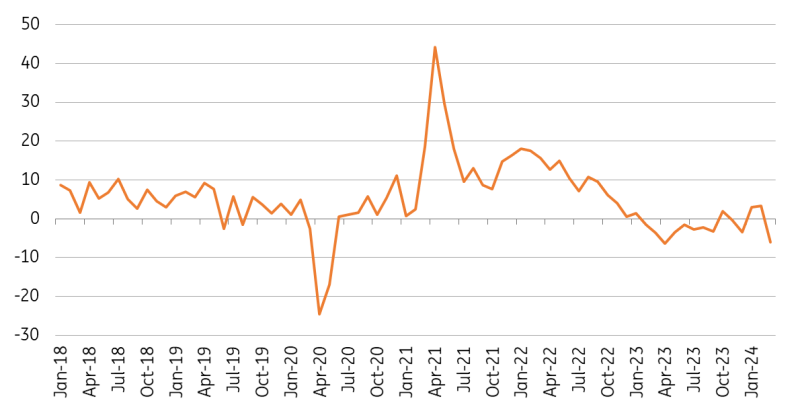Tuesday, April 23, 2024 5:47 AM EST
The March contraction in production seems weaker than the calendar effect would suggest, possibly reflecting weak exports and competition from cheap imports despite the recovery in domestic demand.
Industrial production fell by 6.0% year-on-year in March (ING: -2.4%, consensus: -1.0%;) after increasing by 3.3% YoY in February (data not revised). In our opinion, the year-on-year decline was mainly due to the unfavourable calendar effect (two business days less than a year earlier subtracted approximately 5.7pp). Theoretically, after correcting the data for the calendar effect, the March production rate is similar to February (+0.7% YoY), but we are concerned about the data structure and declines in many industries, not only weak mining but also manufacturing. Also, the Central Statistical Office data, adjusted for the influence of seasonal factors, indicates a decline in production of 3.9% YoY and 5.5% month-on-month.
We hope this poor production is some kind of anomaly. The data is inconsistent with signals of a slow recovery in global industry (and even in Germany) and the stronger domestic demand fuelled by the highest real wage dynamics since the late 1990s. In our opinion, tomorrow's retail sales should show strong domestic demand, just as wages are predicting today. Weak production despite the recovery in domestic demand may indicate still weak exports. We see that companies are increasingly feeling, among other things, competition from Asia, while demand from Poland's main trading partners is still relatively weak.
We see signs of recovery in global industry, although they remain fragile and may suffer from geopolitical tensions. The recovery is uneven, and so far the results of German data, with which the domestic industrial sector is closely linked, have been disappointing. Recent data shows that a slow recovery is finally starting in this economy, but hard data is needed to confirm this.
The production sector should gradually be supported by the recovery of domestic demand, in particular the expected revival of consumption, based on the high growth in household disposable income - the pace of real wages is the highest since the late 1990s and we hope that tomorrow's retail sales data will confirm this.
Industrial production (%YoY)
The industry recovery faded in March, possibly due to weak exports despite stronger domestic demand
(Click on image to enlarge)

GUS
More By This Author:
The Commodities Feed: Middle East Tensions Ease FX Daily: Sterling Makes Its Move Asia Morning Bites For Tuesday, April 23
Disclaimer: This publication has been prepared by the Economic and Financial Analysis Division of ING Bank N.V. (“ING”) solely for information purposes without regard to any ...
more
Disclaimer: This publication has been prepared by the Economic and Financial Analysis Division of ING Bank N.V. (“ING”) solely for information purposes without regard to any particular user's investment objectives, financial situation, or means. ING forms part of ING Group (being for this purpose ING Group NV and its subsidiary and affiliated companies). The information in the publication is not an investment recommendation and it is not investment, legal or tax advice or an offer or solicitation to purchase or sell any financial instrument. Reasonable care has been taken to ensure that this publication is not untrue or misleading when published, but ING does not represent that it is accurate or complete. ING does not accept any liability for any direct, indirect or consequential loss arising from any use of this publication. Unless otherwise stated, any views, forecasts, or estimates are solely those of the author(s), as of the date of the publication and are subject to change without notice.
The distribution of this publication may be restricted by law or regulation in different jurisdictions and persons into whose possession this publication comes should inform themselves about, and observe, such restrictions.
Copyright and database rights protection exists in this report and it may not be reproduced, distributed or published by any person for any purpose without the prior express consent of ING. All rights are reserved. ING Bank N.V. is authorised by the Dutch Central Bank and supervised by the European Central Bank (ECB), the Dutch Central Bank (DNB) and the Dutch Authority for the Financial Markets (AFM). ING Bank N.V. is incorporated in the Netherlands (Trade Register no. 33031431 Amsterdam). In the United Kingdom this information is approved and/or communicated by ING Bank N.V., London Branch. ING Bank N.V., London Branch is deemed authorised by the Prudential Regulation Authority and is subject to regulation by the Financial Conduct Authority and limited regulation by the Prudential Regulation Authority. The nature and extent of consumer protections may differ from those for firms based in the UK. Details of the Temporary Permissions Regime, which allows EEA-based firms to operate in the UK for a limited period while seeking full authorisation, are available on the Financial Conduct Authority’s website.. ING Bank N.V., London branch is registered in England (Registration number BR000341) at 8-10 Moorgate, London EC2 6DA. For US Investors: Any person wishing to discuss this report or effect transactions in any security discussed herein should contact ING Financial Markets LLC, which is a member of the NYSE, FINRA and SIPC and part of ING, and which has accepted responsibility for the distribution of this report in the United States under applicable requirements.
less
How did you like this article? Let us know so we can better customize your reading experience.




